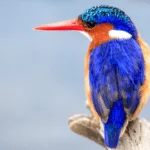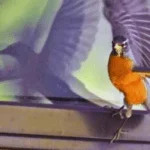Red-chested small bird could be one of several species, such as the ruby-throated hummingbird, the house finch, or the red-billed firefinch, all of which are known for their small size and vibrant red chest feathers.
If you’re looking for a small bird with a dash of color, look no further than the red-chested small bird. With its vibrant red chest, this tiny bird is a delight to behold and adds a splash of color to any natural landscape. Its charming appearance and unique characteristics make it an interesting species to explore.
8 Small Birds with Red Chest
This section will look at eight different small birds with red chests. We’ll look at where these birds dwell as well as some of their frequent behaviors. We’ll also go over how to tell them apart from other birds with red breasts. Let us now investigate the realm of birds with crimson breasts.
1: American Robin

The American robin is a member of the Turdidae family and is found all over North America, including Canada, the United States, Mexico, and Central America. These birds do well in open woods, places that have been farmed, and cities. American robins are usually 9.1 to 11 inches long and have wings that are 12 to 16 inches long. They eat mostly fruits, nuts, and insects. The backs and wings of male robins are gray-brown, and their chests and undersides are red. American robins are often seen in art, literature, and tradition. This is because they are common and have beautiful songs.
2: Painted Bunting
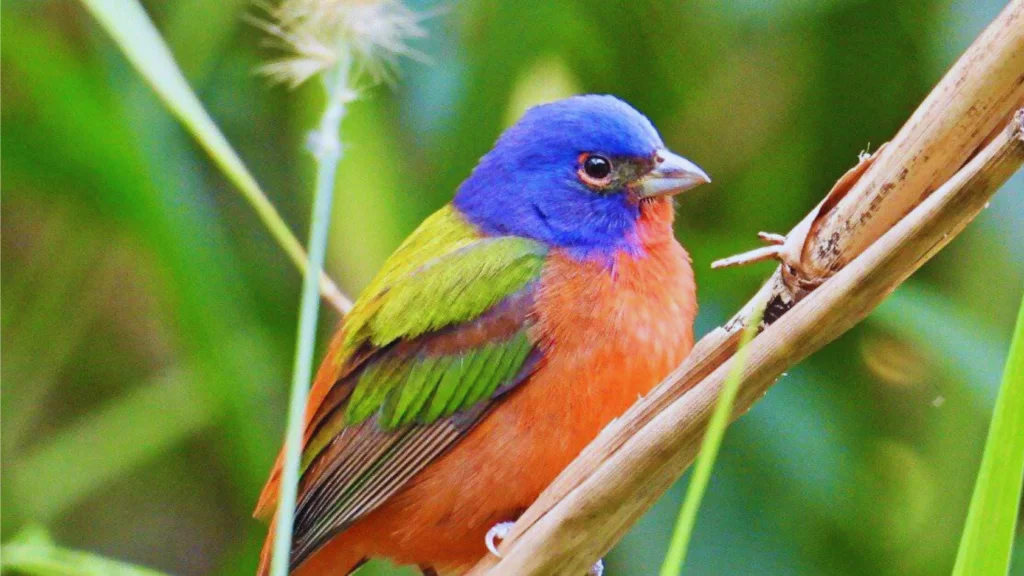
The painted bunting is one of the most colorful songbirds in North America. It lives in forests and thickets near water in the eastern and southern United States. They move to the edges of tropical woods in southern Florida, the Caribbean, Mexico, and Central America during the winter. Males of these birds have blue heads, green backs, and red bellies and underparts. They are about 4.7 to 5.5 inches long. Even though male painted buntings are shy and keep to themselves, they can be aggressive and even fight to the death. But their number of people is going down.
3: Pyrrhuloxia
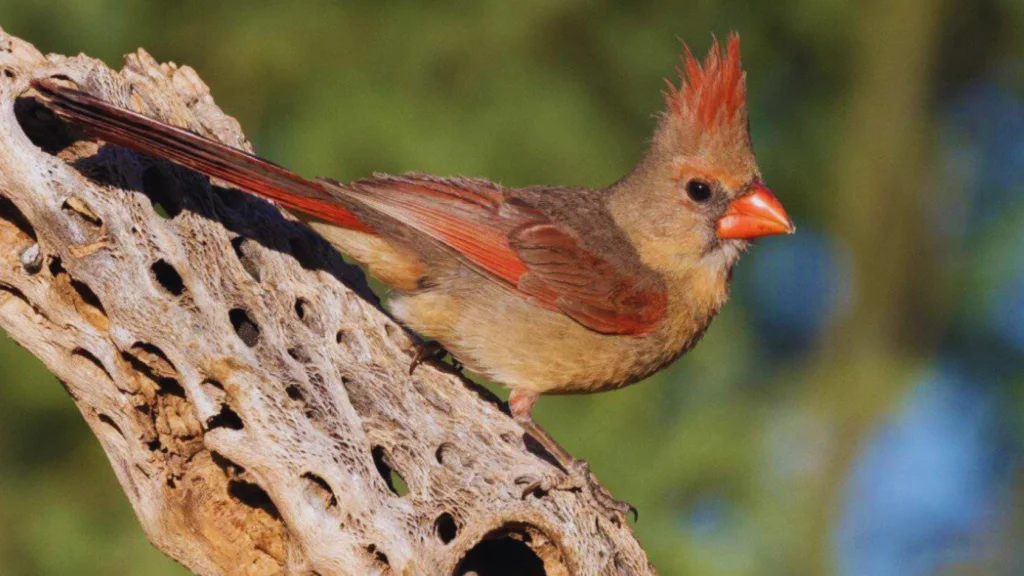
The Cardinalidae family includes Pyrrhuloxias, which look like northern cardinals and are often mistaken for them. These birds live in dry parts of Arizona, New Mexico, Texas, and Mexico. They like to live in thickets of scrubland and mesquite. Pyrrhuloxias are about 8.3 inches long, and they have short, thick beaks and tall crests. The males have dark red crests, faces, and breasts, and their tails and wings have red streaks. The rest of their feathers are mostly gray-brown.
4: Red-Breasted Sapsucker
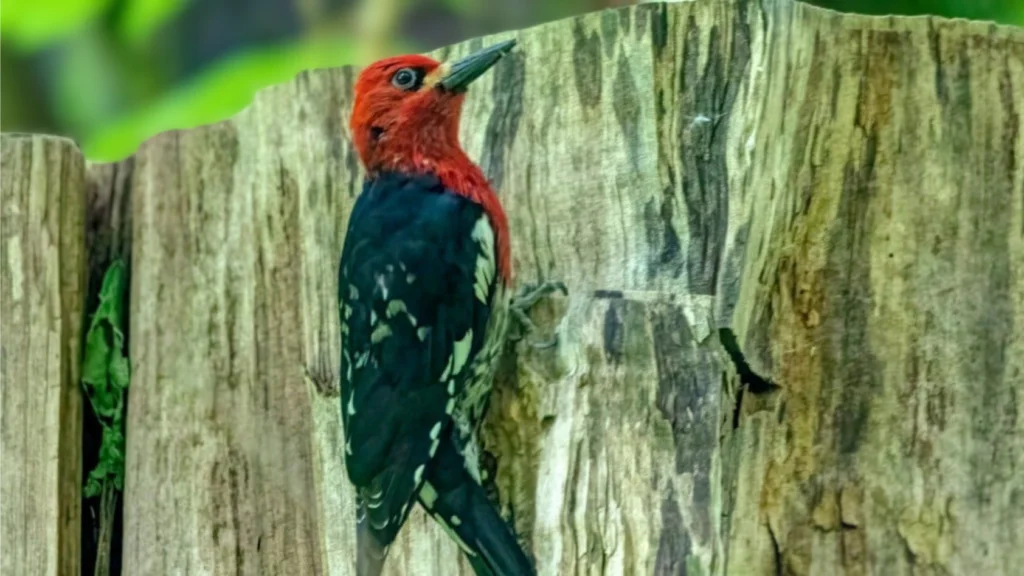
Red-breasted sapsuckers live in the woods along the west coasts of Canada, the United States, and Baja California. They are part of the Sphyrapicus genus, which is in the woodpecker family. These birds make holes in trees to get to the sap, which they drink with their long, hairy tongues. They also eat seeds, berries, and animals that get in through the holes in the sap. Male red-breasted sapsuckers have red heads and breasts, but their backs are black and their bellies and underparts are white.
5: Vermilion Flycatcher

The vermilion flycatcher is a member of the Tyrannidae family and lives all year in the southern United States, Mexico, Central America, and the northwestern part of South America. The males of this species have bright red feathers on their heads, necks, breasts, and undersides. Their backs and wings are brownish-gray. Vermilion flycatchers are between 5.1 and 5.5 inches long and eat mostly bugs like flies, grasshoppers, beetles, and bees.
6: Painted Redstart
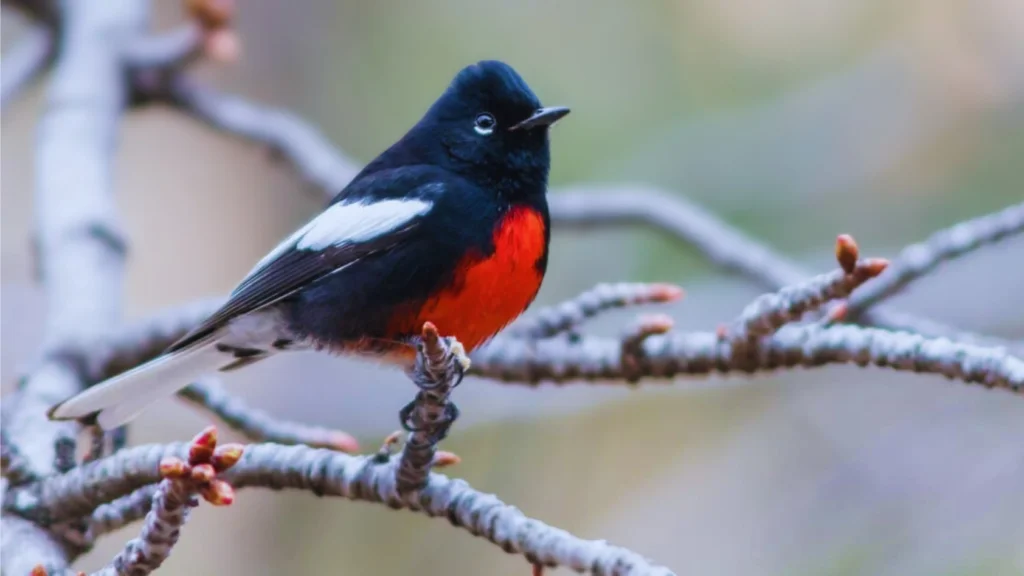
The painted redstart is a type of New World warbler that lives mostly in the mountains of Central America’s interior, near streams and wooded valleys. These birds are about 5.1 to 5.9 inches long, which is longer than most warblers. Painted redstarts hop along trees and spread their wings and tails to scare away insects. They build their nests on the ground. Both males and females have shiny black backs, heads, tails, and wings, and their bellies are a bright red color.
7: Rose-Breasted Grosbeak
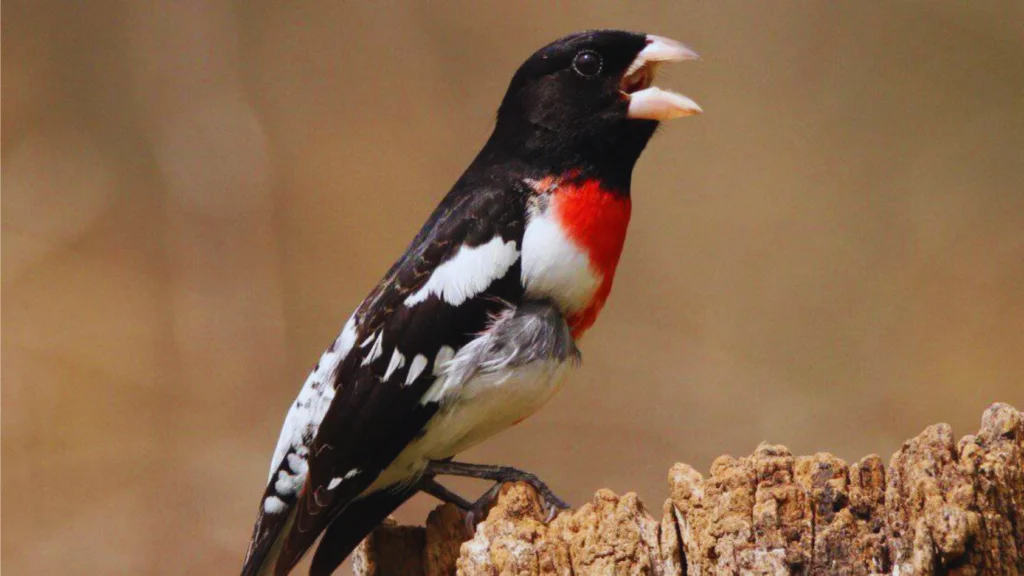
The rose-breasted grosbeak is a member of the Cardinalidae family. It is also called the “cut-throat.” During the summer, they live in the southern part of Canada and the eastern part of the United States. In the winter, they move to Mexico, Central America, and the Caribbean. Rose-breasted grosbeaks are usually found in open wooded places and range in length from 7.1 to 8.7 inches. Males have a red patch in the shape of a v on their bodies. Their heads, backs, tails, and wings are all black, but their bellies are white.
8: Scarlet Robin

The scarlet robin, belonging to the Petroicidae family, is a small songbird endemic to Australasia. These birds are found along the coasts of southern Australia and throughout Tasmania, favoring eucalyptus forests, scrublands, and urban areas for nesting. Male scarlet robins exhibit scarlet feathers on their breasts, contrasting with black heads, backs, and tails, as well as white bellies, foreheads, and underparts.
Characteristics of the Red-Chested Small Bird
The red-chested small bird, also known as the red-breasted bird, is a tiny avian species with a distinctive red chest that adds a pop of vibrant color to its appearance. These charming birds are roughly 4 to 5 inches in length and have a wingspan of about 7 to 8 inches. Their bodies are slim and compact, with a slightly curved beak that helps them feed on various types of foods.
The most recognizable feature of the red-chested small bird is, of course, its red chest. The feathers on their chest are a rich crimson color that fades to a lighter orange on their underbelly. Its back is a brownish-grey color, and its wings and tail are mostly brown with black markings. The female red-chested small bird has a slightly duller appearance than the male, with a less vibrant color on its chest.
Characteristics of the Red-Chested Small Bird:
| Physical Characteristics | Appearance |
|---|---|
| Size | 4-5 inches in length, wingspan of 7-8 inches |
| Shape | Slim and compact body with slightly curved beak |
| Color | Crimson chest, brownish-grey back, brown and black wings and tail |
The red-chested small bird is a fascinating creature to observe and study, with its unique physical characteristics making it easily identifiable in its habitat.
Habitat and Distribution of the Red-Chested Small Bird
The red-chested small bird is a common species found in various habitats around the world. From the forests of North America to the woodlands of Europe, this petite avian creature is a delightful sight for birdwatchers and nature lovers.
These birds can primarily be found in wooded areas with dense tree cover and undergrowth. They prefer habitats with a mix of deciduous and coniferous trees, as these provide plenty of food and shelter for them.
In North America, the red-chested small bird can be found in many parts of the United States, from the Northeast to the Southwest. They can also be found in Canada, particularly in the eastern parts of the country.
In Europe, their habitat extends from the British Isles, across the mainland to the forests of Eastern Europe. They are also found in parts of Asia, including China and Japan.
These birds are mostly non-migratory but may move to different locations within their range during the winter months or in response to changes in their environment, such as forest fires or deforestation.
Threats to Habitat and Distribution
The red-chested small bird faces threats to its habitat and distribution due to human activities such as deforestation, urbanization, and agriculture. These activities have led to the destruction or fragmentation of forests and woodlands, which reduces the availability of suitable habitats for birds.
Climate change is also impacting their range and distribution, as the birds rely on specific environmental conditions, such as temperature and precipitation, to survive and thrive.
Conservation efforts have been put in place to protect the habitats of these birds and ensure their survival. These efforts include the preservation of forests and woodlands and the protection of critical breeding and nesting areas.
Diet and Feeding Habits of the Red-Chested Small Bird
The red-chested small bird has a varied diet, consisting of insects, seeds, fruits, and nectar. Its preference for these foods may vary based on availability and season. The unique feeding habits of this avian species are sure to delight birdwatchers and nature enthusiasts alike.
One interesting behavior related to feeding is its use of its curved beak to extract nectar from flowers. This petite bird with a scarlet chest often hovers near flowering trees and plants, sipping nectar with its long tongue. It also consumes insects, such as caterpillars, beetles, and spiders, plucking them from leaves or the air.
| Diet of the Red-Chested Small Bird | Feeding Habits |
|---|---|
| Insects (caterpillars, beetles, spiders) | Plucks insects from leaves or out of the air |
| Seeds | Picks seeds off the ground or from vegetation |
| Fruits | Eats ripe fruits when available |
| Nectar | Uses its curved beak to extract nectar from flowers |
This crimson-breasted flying creature often forages in the lower strata of the forest, searching for its preferred foods. While it may feed alone, it is also known to join mixed-species flocks and forage with other birds. These flocks may consist of different bird species that work together to locate food, providing safety in numbers.
The diet and feeding behavior of the red-chested small bird contributes to its vital role in the ecosystem, helping to pollinate plants and regulate insect populations. Its small size and unique feeding habits also make it a fascinating and charming species to observe.
Breeding and Nesting Behavior of the Red-Chested Small Bird
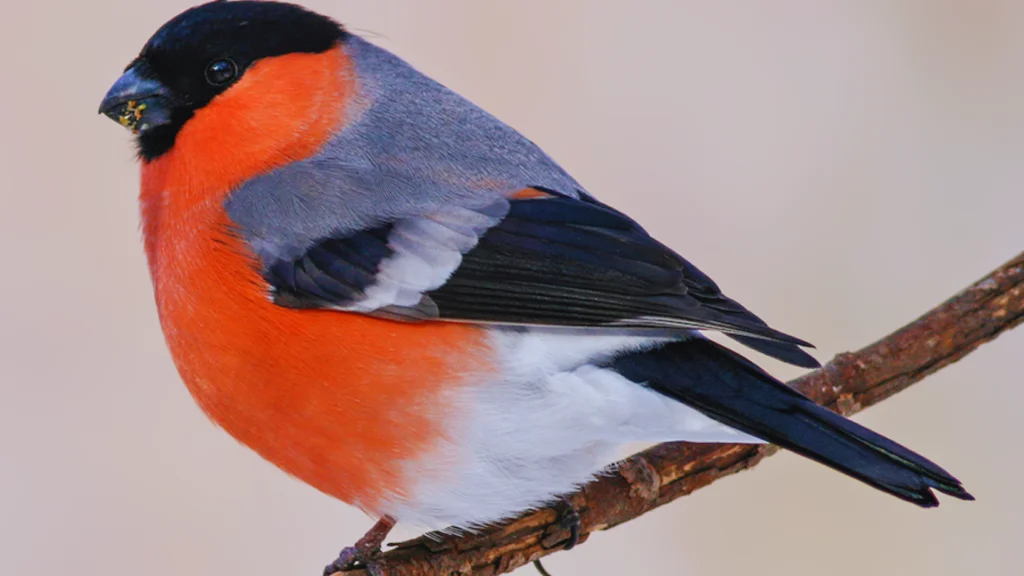
The red-chested small bird is known for its interesting mating and nesting behaviors. These petite birds mate for life and are known to form strong bonds with their partners. During the breeding season, the male bird will perform a courtship dance to attract a female mate. The dance involves hopping around with fluttered wings while making chirping sounds.
Once the pair has bonded, they will start to build a nest. The nests are typically made of twigs, leaves, and other plant materials, and are located in trees or shrubs. The female lays two to five eggs, which are incubated by both parents for about two weeks.
After hatching, the chicks are fed by both parents and grow quickly. Within a few weeks, they are ready to leave the nest and start their own independent lives. The red-chested small bird may have several broods per year, depending on the availability of food and other resources.
In some cases, the red-chested small bird may engage in cooperative breeding, where several individuals work together to raise the young. This behavior is more common in areas where resources are scarce or unpredictable and can help increase the survival rate of the chicks.
Overall, the breeding and nesting behaviors of the red-chested small bird are fascinating to observe and study. Their strong bonds, intricate courtship dances, and cooperative behaviors make them a unique and valuable part of the avian world.
FAQs about the Red-Chested Small Bird
As a charming and delightful small bird with a vibrant red chest, the red-chested small bird often attracts curious observers. Here are some of the most frequently asked questions about this petite avian species:
How long does the red-chested small bird live?
On average, the red-chested small bird can live up to 5-7 years in the wild. However, some individuals in captivity have been known to live up to 10 years.
Does the red-chested small bird migrate?
Yes, some populations of the red-chested small bird do migrate during the winter months in search of more favorable feeding grounds. The extent and distance of migration depend on the location and climate of their habitat.
How does the red-chested small bird interact with humans?
The red-chested small bird is a shy and elusive bird that prefers to avoid human interactions. However, they may visit gardens or backyards in search of food sources such as nectar or seeds. It is important to respect their space and not disturb their natural habitat.
What is the scientific name of the red-chested small bird?
The scientific name of the red-chested small bird is Cercotrichas leucophrys.
How can I attract red-chested small birds to my garden?
To attract red-chested small birds to your garden, you can create a bird-friendly environment by planting native plants, providing food sources such as nectar and seeds, and providing a clean source of water for drinking and bathing. Avoid using pesticides or chemicals that may harm the bird or its natural habitat.
Does the red-chested small bird have any predators?
The red-chested small bird faces threats from predators such as snakes, birds of prey, and small mammals. They rely on their camouflage and evasive instincts to avoid being preyed upon.
Are there any interesting behaviors associated with the red-chested small bird?
Yes, the red-chested small bird is known for its unique vocalizations, especially during the breeding season when males sing to attract a mate. They also have interesting feeding behaviors, such as hovering like hummingbirds to consume nectar.












